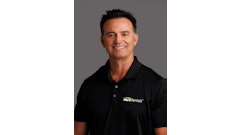
Powered access equipment, both aerial work platforms and mast climbing platforms, are an efficient means of gaining temporary access to work at height. That said, work at height has some inherent dangers that must be considered to maintain safe working conditions.
IPAF’s recently initiated accident reporting program has identified electrocutions as a leading hazard associated with fatalities during the use of powered access equipment. Electrocutions were the single largest cause of AWP operator fatalities in the U.S. in 2012. Armed with this fact, IPAF is raising awareness of this potential hazard and has developed a simple plan to keep powered access workers safe.
Electrocutions can be prevented through proper planning, risk assessment and management of work at height, including thorough operator training and familiarization. IPAF offers the following safety guide that an AWP operator can apply on any job with identified overhead power lines:
IPAF recommends the minimum approach distance from a power line mounted on a wood pole be 30 feet and 50 feet from a steel tower (from the closest point of the AWP when fully extended). Almost as simple as looking both ways before crossing the street, this guidance, when followed, can save lives.
The reality is that workers are too often focused on their task and not on their surroundings. An operator can easily forget about their proximity to power lines and get too close for safety. You do not need to touch a power line before it ‘jumps’ and runs dangerous current to you or the machine.
Use minimum approach distances
Identifying all power sources on the site and placing clear barricades or warning flags either 30 feet away from wood poles and 50 feet from steel towers can prevent an accident from occurring. A qualified person has to identify the voltage of the power source to determine any minimum approach distances (MAD) that might be less than those previously stated.
IPAF’s safe distance rule acknowledges that most operators are not qualified to identify the line voltage and offer a conservative and extremely safe distance that an operator can follow without guidance from others. If a qualified person defines the line voltage and determines a closer MAD, the operator can act accordingly.
It is also important to keep in mind that AWPs are mobile and boom-type lifts can extend well beyond the base of the machine. While an operator can set the base of a boom lift 30 feet away from the power source, the platform can extend well beyond the base and place the worker at risk. This is why the IPAF guidance states an operator must remain 50 feet away PLUS the length of the machine's fully extended platform.
Take all variables in to account
IPAF performed a demonstration at CONEXPO on how to implement this guidance. As you might imagine, a scissor lift travels vertically, so measuring 30 or 50 feet horizontally from the power lines is easy to mark. In fact, we recommend that the safe distance is marked with some easily seen marker of flags to make the safe distance visible and clear while working.
A boom-type lift, however, has variable distances that it can extend beyond the base of the machine. If you simply measure the 30 or 50 feet horizontally from the power lines and park the base there, the work platform can extend into the safety zone and place the workers at risk. You MUST take into account the extendable length of the platform to the 30 or 50 foot safe distance and not allow the base of the boom to cross that line.
Also, remember that some power lines could be very high and it might be possible to drive under them and maintain a safe distance. It is when the mind focuses only on completing a task that the operator can extend the platform into a dangerously close or fatal distance from the overhead power lines.
The old adage “better safe than sorry" is one that still applies to overhead power lines. Knowing the IPAF distance guidelines is a starting point that must be added to your risk assessment to ensure the operator does not inadvertently come too close or touch the power source. Implementing a plan on how you apply the guidance is essential to your good health.





















